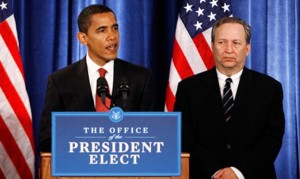In the end, the two failing automakers got enough cash for a temporary reprieve, the outgoing Bush Administration punting the problem of how to save General Motors and Chrysler to its successor, Barack Obama. But a lengthy memo from former National Economic Council Director Lawrence H. Summers to the president-elect reveals Pres. George W. Bush gave serious consideration to accelerating the move to put GM and Chrysler into bankruptcy.
The 57-page memo is revealed, for the first time, in the New Yorker magazine’s website. Summers, who also served as co-auto czar for the new administration, penned the note on December 15, 2008, four days before Pres. Bush authorized the payment of $17.4 billion to the two makers. He approved $25 billion for the makers and their equally troubled captive finance arms before the Obama Administration took office a month later. In all, the automotive bailout would ultimately reach $85 billion.
The memo covered far more than just the automotive bailout, noted New Yorker’s Ryan Lizza, who termed the document, “the ur-text for economic policy-making for the Obama Administration.”
With time short, Bush eventually gave up on the idea of crafting a bailout – which had already been blocked by the Republican-dominated Congress. But he considered other options – including the procedure that was eventually adopted by the Obama White House, tapping into the $700 billion Troubled Asset Relief Program, or TARP, funds originally approved for the Wall Street rescue.
“Under this approach,” Summers wrote, “the administration would announce a willingness to extend TARP funds as a DIP loan once a company has filed for bankruptcy. Given GM and Chrysler’s current cash positions, it is overwhelmingly likely that one or both would be forced to file before or immediately after the New Year.”
DIP, or Debtor-in-Possession, financing would be provided following a bankruptcy filing, with no strings attached, unlike the eventual approach, which gave the White House a majority stake in GM and a large share of stock in Chrysler – the latter eventually turned over to Italy’s Fiat as part of the terms of its bailout.
Ultimately, it appears that the outgoing administration was convinced that haste would, in this case, make waste, a rapid move to declared bankruptcy “resulting in potentially severe disruption to the entire industry. With a couple of weeks planning, they could achieve an orderly filing.”
Chrysler declared Chapter 11 in April 2009, ultimately receiving $12.5 billion in aid from the Treasury. Pres. Obama initially balked at a bailout for what was seen as the more troubled of the two domestics, but reversed his position when it was agreed Fiat would step in.
The Italian maker initially received a 20% stake, but has steadily increased its holdings to 58.5% after paying off the government loans and meeting a series of other hurdles. Earlier this month, it got the last 5% authorized by the White House for adding a new 40 mpg version of the new Dodge Dart to its line-up. Fiat eventually has said it would like to push its stake to 70% or higher, the remaining shares currently held by the United Auto Workers Union’s VEBA health care trust.
As for GM, it followed Chrysler into bankruptcy two months later, after receiving $6 billion more in bridge loans. Another $30 billion in DIP financing was provided while GM was under court protection.
The White House held a two-thirds stake in GM following its emergence from bankruptcy, about half of those shares sold off in a November 2010 IPO. The maker has not stated its plans for selling off the remaining stake, reflecting the sharp tumble in the market in recent months, auto stocks particularly hard hit.
In recent days, GM shares have rebounded to around $25, a significant improvement over their $19.00-a-share, 52-week low – but far below the IPO strike price of $33, and the 52-week high of $38.95. Various industry analysts have forecast that longer-term, GM shares could rise to anywhere from $40 to $50, the latter making it possible to break even on the bailout.
At the current trading level, however, the Treasury would lose $12 billion on GM – on top of the $1.5 billion in write-offs on the original Bush loans to Chrysler. Including other organizations that received help under the auto bailout, the Obama Administration has warned it expects to lose $23.6 billion overall.
But losses were clearly anticipated from the moment GM and Chrysler expressed the need for help to avoid shutting down – a move both the Bush and Obama White Houses said could lead to the loss of over 1 million jobs.
“While there may be ways to mitigate the government’s loss in the context of an eventual bankruptcy filing, the government is unlikely to recover the full value of any bridge investment,” Summers memo warned the then-new Pres. Obama.

